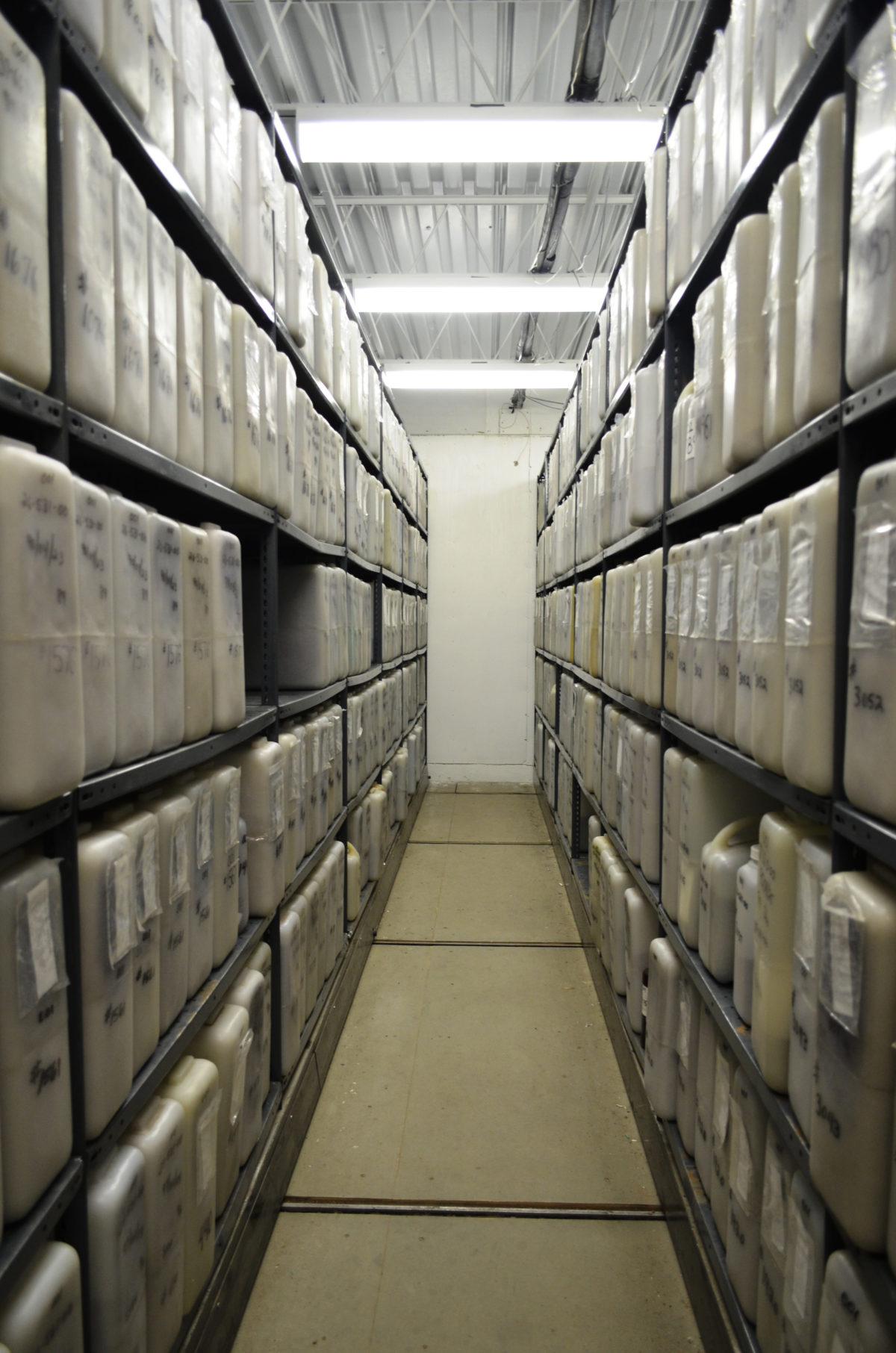Ministry Announced the closure of the Ontario Tree Seed Plant
On August 23 2017, the Ministry of Natural Resources and Forestry (MNRF) announced the closure of the Ontario Tree Seed Plant, effective September 2018.
The Ontario Tree Seed Plant and its public seed bank provide genetically appropriate seed for reforestation on Ontario’s Crown land, afforestation planting programs such as the 50 Million Tree Program and Species at Risk Farm Incentive Program on private land, and an open service available to all Ontarians, from landowners to school groups to growers, to purchase a variety of native species’ seeds at a reasonable cost for any project. Since 1923, this unique facility and its staff have provided expertise and best practices to ensure high quality, source-identified seed is translated into successful planting projects that preserve Ontario’s biodiversity, protect our water, air and soils, and support jobs in the nursery, forestry and wood manufacturing sectors. Read about the Ontario Tree Seed Plant’s 90th Anniversary Celebration here. In response to the August 23rd closure notice, the Ontario Tree Seed Coalition quickly formed from concerns users of the OTSP. In the last two months, Coalition members have made the following recommendations to the Minister of MNRF:
- MNRF to work with the Seed Coalition and other stakeholders to develop a transition plan to ensure continuation of the critical services provided by the Ontario Tree Seed Plant beyond the September 2018 deadline;
- Ensure the chain-of-custody for seed in Ontario is not disrupted in the transition process;
- Ensure the continuous supply of biologically appropriate seed, so Ontario’s reforestation and afforestation practitioners can react and adapt to a changing climate;
- Secure the seed bank currently being managed for the public good by MNRF to facilitate the above options for Ontario practitioners.
As of today, we have had limited response to these recommendations and MNRF is proceeding with its plans to empty out the seed bank beginning late November. We are therefore asking for anyone with an interest in the OTSP, and the essential services it provides to take action and speak up. Several options are provided below. You can sign the Change.org petition, collect 25 or more original signatures to mail to MPP Jim Wilson (Simcoe-Grey), or submit a letter to the Minister of MNRF (and others CC’d in the draft letter template). Particularly for professional organizations, please customize the letter template to express your concerns, and describe how the closure of the Ontario Tree Seed Plant will affect you, your restoration needs and our collective environment now and in the future. Please pass this post to your members or other contacts through your network. The proposed September 2018 closure and the MNRF actions towards that make this an extremely urgent matter. Finally, the Seed Coalition invites you to contact us if you have any questions or would like to know how these impacts may affect your programs further. There are several avenues of adding your voice below.
Having a Meeting or Conference?
Download Informational Poster and Petition for 25+ Signatures to mail to MPP Jim Wilson
Concerned Organization?
Download Letter Template to Ontario Govt re Seed Plant Closure Nov 1 2017 Read FGCA’s Letter to the Ontario Government Re: Ontario Tree Seed Plant Closure (November 2, 2017), also posted in full on the AWARE Simcoe website.
Links to other recent news on the Ontario Tree Seed Plant: November 15, 2017: MPP Jim Wilson questions government again over the Ontario Tree Seed Plant closure https://www.youtube.com/watch?v=enVslgcGm90&sns=em https://aware-simcoe.ca/2017/08/mnrf-closing-angus-seed-plant/ The Working Forest, November 9, 2017: Closing Seed Facility Risks Forests’ Future CBC Radio’s Ontario Morning with Wei Chan, October 13, 2017, forward to 15:00 Simcoe.com, October 7, 2017: MPP Jim Wilson wants province to re-think closure of Angus seed plant CTV News Barrie, August 28, 2017: Major seed distributor to be shut down in 2018 For questions, comments or feedback, please contact: Barb Boysen FGCA General Manager, [email protected] Melissa Spearing, Seed Program Coordinator [email protected] Please continue reading about the history and importance of this facility below.
By Barb Boysen and Melissa Spearing
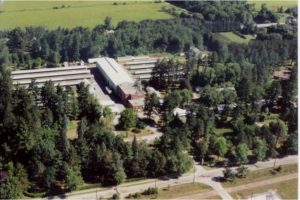
Who sees Ontario’s forest for the trees? Are they healthy? Are they regenerating? If not, and if tree planting efforts cannot keep up, we may lose the native forests and canopy that conserve our soil and water, clean our air and moderate our climate, no matter what pressures come. What about the future forests? How many of us see seedlings in the forest or seed on the trees? Do your kids know acorns come from oaks? Do you know it takes pines and red oak two years to develop seeds but only one for white oak and spruce? That most species don’t produce seed every year?
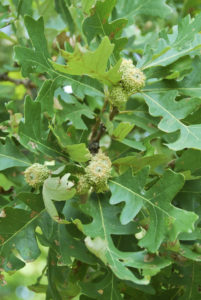
Though most people love trees, few understand these natural patterns and complexities involved in planting. Seed is the basis of forest restoration and its steady patterns may be threatened by climate change. The Ontario Tree Seed Plant (OTSP) has been the provincial centre of operational tree seed expertise since 1923. At that time, growing deserts in southern Ontario prompted Premier Ernest Drury and Chief Forester Edmund Zavitz to establish county forests, provincial parks and a large, successful afforestation program using local seed produced in local nurseries. John Bacher’s Two Billion Trees and Counting describes the partnership as:
“…one of the rare cases in forestry when the combination of professional knowledge and political commitment established a process that provided long-term benefits to future generations. Homegrown stock was produced to avoid further disasters stemming from importation from the United States [and] stock contaminated with blister rust, which had come from Germany.”
Ministry of Natural Resources (MNR) staff coordinated all aspects of seed for the government’s forestry programs that annually planted over 100 million trees on Crown Land and up to 20 million on private land in southern Ontario, all from seeds processed at the OTSP. Those trees became the forests that today are visible on Google Maps, benefitting millions of Ontarians with sustainable timber products, wildlife habitat, and areas for recreation and leisure. In the mid-90s, government cutbacks ran deep and we lost the MNR reforestation program. The nurseries Drury and Zavitz established were sold and the Seed Plant was to be privatized. In 1998, the Forest Gene Conservation Association (FGCA) worked with stakeholders to help MNR management understand that tree seed expertise and banking is a big picture commitment. Even private nurseries argued for the Seed Plant to be kept. Only the provincial government could, or effectively would take on this responsibility. In 1999, MNR leadership decided to keep the OTSP to help ensure seed would be genetically adapted to local planting sites. This centre of seed processing, purchasing and sales made it easier to monitor and influence the seed sources used on the landscape. Consumers trusted what they were buying and didn’t have to turn to US seed houses, which rarely identified source information. With this support, tree nurseries were also able to increase the planting of locally adapted trees for urban planting programs. The OTSP’s services and seed banking capabilities were the foundation for the 50 Million Tree Program in 2007. Almost 20 years later, we’re in crisis again with the announcement that the OTSP will close in September 2018. FGCA, Forest Ontario, Sustainable Forest License holders, growers and planting partners are concerned about the implications.
- Where will clients move their millions of stored seeds?
- Where will next year’s crops be processed and banked? The cyclical nature of good seed crops in most tree species means growers cannot depend on having fresh seed the year he/she needs it.
- Who will communicate with local seed collectors?
- Who will consistently monitor and test seed quality?
- Will anyone manage the long-term seed bank that is required for an uncertain future, that no one private organization would invest in?
Amid these many concerns and questions, we must understand what we’re losing before it’s too late. The Ontario Tree Seed Plant story is about special people and not many of them. These dedicated planners, seed collectors, processors, testing and storage experts are a rare breed. The planners provide essential oversight. They monitor the status of seed banks versus annual seed needs. They communicate with forest managers and nurseries to set annual collection targets. And then they talk to collectors about what’s developing. They then advise new and experienced collectors about what, where, when and how much to pick. Never abundant and getting rarer are the seed collectors. Picture people picking cones from logging slash, from squirrel caches in mature stands. Spreading tarps under oak, hickory, and maples. Watching butternut and cherry crops every day in the fall to avoid losing it all to birds and squirrels. Many collectors have picked seed of dozens of species for decades. Some have taught their children and friends. Many drive hundreds of kilometres each year to sites known for good seed. The OTSP, and thus growers and planting programs, depend on them.
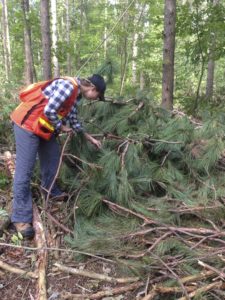
They observe the annual vagaries in weather and seed crops. They cut open cones and fruits to see if tiny embryos are maturing properly. They handle it all very carefully so that the seed will grow into vigorous seedlings. Seed is shipped to the Seed Plant from across Ontario. Refrigerated trucks carry hundreds of 40-pound burlap bags of black spruce, jack pine, red pine, white pine and white spruce. Purolator shipments arrive daily or collectors drive it in themselves as soon as it is picked to ensure quality is maintained. At the Seed Plant, the few staff, each with decades of experience, know what to do with dozens of species’ seed. Short-lived seed from oaks and maples are assessed and go quickly to tree nurseries for sowing. Cones are stacked in thin layers on screens to dry down further, ready for kilning. Millions of seed will be extracted from hundreds of thousands of cones. Some seed is used annually, but most are stored, sometimes for decades, a hedge against years without quality seed crops.
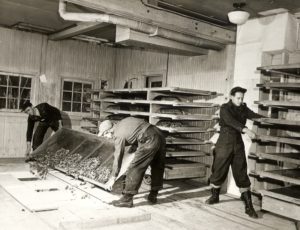
Seed to be stored is dried to a specific moisture content, catalogued, then sealed in air-tight containers and kept in the –18°C freezer. Internationally standardized testing procedures determine the percentage that should germinate for the growers, which seed can be stored longest, or if they need to collect more often. The freezer is tornado-proof, flood-proof and backed up by generators in case of power failure. Necessary measures to protect an irreplaceable legacy – our forests’ future.
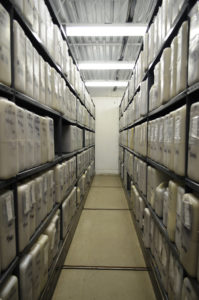
Through each step, the seedlot is labelled by collection source. Township X, County Y, Seed Zones 4 through 38. This tracking and labelling system has always been extremely important in order to return seed to where it is best adapted, and even more so now that our climate is rapidly changing. The latest climate models indicate that southern Ontario will be the best source of seed for northern Ontario before 2100 because the southern populations are already genetically adapted to warmer climates. But we are losing valuable populations and expertise before we have banked enough seed. Many southern forests have been lost to agriculture and development. Globalization inadvertently introduced exotic insects, diseases and plants that will suppress or kill billions of trees and prevent future forests from regenerating. This is currently evident in the FGCA’s work on conserving ash seed ahead of the emerald ash borer front, sent to the National Tree Seed Centre in Fredericton, New Brunswick; almost no seed is to be found after the insect has done its work. Beech bark disease is causing similar stress on future seed production, a valuable food for wildlife. Hemlock woolly adelgid may also eliminate viable seed production on this important but slow-growing climax species. Oak wilt may be next. Given these significant threats to our forests, seed collection and banking of all native species needs to be increased to give us options for future regeneration. The stakes are high and uncertainty is the reality. In the absence of a guaranteed readily accessible supply of high quality native seed to perpetuate and enhance future forests, especially in the face of climate change, Ontario is at greater risk of:
- Eroding the social, stewardship and cultural heritage values and equality we associate with healthy forests and the broader natural environment
- Increased public health costs in relation to mental health, sedentary lifestyles and childhood development, and inequitable access to nature between wealthy and impoverished communities
- Declining environmental quality indicators where tree cover protects water quality, soil carbon stocks and filters air of pollutants
- Decreasing agricultural yields due to soil erosion, wind and loss of habitat for beneficial pollinator species
- Increased exposure to extreme weather events, including more homes and businesses at risk of flood damage
- Losing scalable economic opportunities and future adaptation options in the forestry sector and rural areas, including diversified agriculture, emerging wood bioenergy and carbon offset markets
- Continued loss or regional extinction of native and at-risk species (birds, mammals, amphibians, insects, and minor plant species in particular) dependent upon Ontario’s forested landscapes and a breakdown of natural heritage systems to facilitate gene flow along natural migration pathways
- Continued intrusion of invasive species on natural and managed lands, thus increasing economic impact and costs for research, control and eradication efforts
Since 1996, the FGCA has learned that the best strategy with a complex challenge like forest restoration is to make it easier for people to do the right thing. Losing government investment, involvement and oversight, seed processing facilities, and seed banking expertise will make this challenge more difficult. As our government has recognized through the Climate Change Action Plan, this is the time to strengthen our commitment to forest restoration and climate action. We need leadership with an eye on the big picture of sustainable forests in 2100 and beyond, because there’s no future without forests and no forests without seed.
